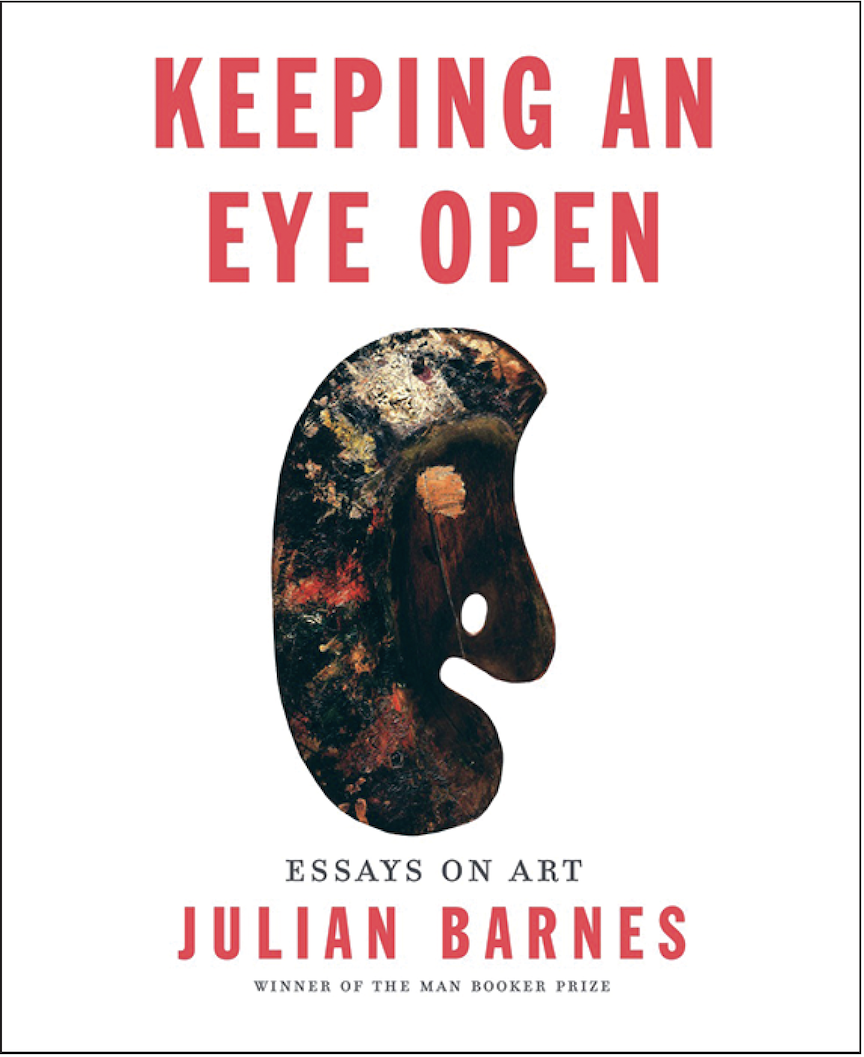Keeping an Eye Open
Essays on Art by Julian Barnes

Julian Barnes, Keeping an Eye Open: Essays on Art, 2015, Random House Canada.
Is art what catastrophe is for? Such is the question that structures the opening salvo of Julian Barnes’s recently published collection of writings on art, Keeping an Eye Open. The question is one that seems all the more pressing in light of the recent catastrophes in Paris, and around the world for that matter. Can pictures tell a better story of “unspeakable” events? Are they really “worth ten thousand words?” Citing Georges Braque, who thought, as Barnes explains, “the ideal state would be reached when we said nothing at all in front of a painting,” and looking to Lucian Freud, who maintained that any words he said about his work would be “as relevant as the noise a tennis player makes when playing a shot,” Barnes would have us believe language is woefully under-equipped for its own descriptive task. And yet, his book betrays a deeper faith in the written word, offering a way in to the pictures he describes through the words he so deftly chooses.
Keeping an Eye Open contains 17 essays written between 1989 and 2013 on subjects ranging from the “funereal look” of Fantin-Latour’s family portraits to the “upward surge” of Odilon Redon’s art, and back down to earth again with meditations on Ron Mueck’s Dead Dad, which Barnes aptly describes as possessing “the silence and strength of a work of art that keeps its secrets.” Throughout the book Barnes’s prose is understatedly elegant, and at times deliberately provocative in its colloquialism. In reference to Édouard Vuillard’s Ker-Xavier Roussel Reading the Newspaper, 1893, he writes that the sitter appears to be “reading the crotch of his own fancy two-tone trews.” When seen “en masse,” Félix Vallotton’s nudes “seemed to demonstrate all too thumpingly what might be called Vallotton’s law: that the fewer clothes a woman has on in his paintings, the worse the result.” Claes Oldenburg’s work is, spectacularly, “about as political as a hot dog, and as mystical as a Hoover.” Barnes’s language writes pictures as they really are—without condiments, unadorned by art-historical or theoretical jargon.
Indeed, Keeping an Eye Open is not a scholarly text. It makes no claim to new interpretation or groundbreaking research. Yet it is a book that offers an important lesson to anyone deeply engaged in looking at pictures. Keeping an Eye Open illuminates the virtues of willed ignorance when it comes to the visual encounter. This is not to say that the book is ignorant (on the contrary), only that it stays true to the experiential immediacy of feeling something in front of a work of art.
The dream of consciously letting go of what we know when looking at or making a picture is one shared by artists innumerable and voiced most persistently in the 19th century. Baudelaire’s quintessential painter of modern life looked at the world with the eyes of a child. In his letter to Émile Bernard (Correspondance, Oxford, 1976), Cézanne spoke of painting only “what we see, forgetting everything that existed before us.” He was neither the first nor the last to express such a wish in the context of an artistic endeavour. Writing about Théodore Géricault’s Raft of the Medusa, 1818–1819, Barnes himself entreats readers to “reimagine our eye into ignorance,” cultivating a naiveté that forces us to see pictures anew. In one of the most compelling and beautiful passages in the book, Barnes argues that when we look with an “ignorant eye” at the Raft of the Medusa, “We don’t just imagine the ferocious miseries on that fatal machine; we don’t just become the sufferers. They become us….There is no formal response to the painting’s main surge, just as there is no response to most human feelings. Not merely hope, but any burdensome yearning: ambition, hatred, love (especially love)—how rarely do our emotions meet the object they seem to deserve? How hopelessly we signal; how dark the sky; how big the waves. We are all lost at sea, washed between hope and despair, hailing something that may never come to our rescue.” Pictures are always inextricably bound to the moment in which they are made, but often the most enduring works of art are those that are able, in Barnes’s words, to “[slip] history’s anchor.”
Neither art history, nor biography, nor formalist critique, Barnes’s book is perhaps best described as novelistic in its approach. Barnes seeks out the stories behind pictures, and the people and processes that went into their making. He is arguably at his best when he prompts readers to craft their own responses to works of art through the kinds of questions he poses. “How far does an artist’s individuality develop as the result of pursuing and refining the strengths of his or her talent, and how much from avoiding the weaknesses?” he asks in the context of an essay on Odilon Redon. To his readers he wonders, “Isn’t there something slightly disappointing about our need to equip all artists with a certificate of darkness?” These are not questions that Barnes attempts to answer definitively in his book, but they are questions that force us to “keep an eye open,” as his title prescribes, protecting against the risk we all run of merely taking pictures for granted. ❚
Keeping An Eye Open: Essays on Art by Julian Barnes, Random House Canada, 2015, 228 pages, $34.95.
Mary-Dailey Desmarais, PhD, is Curator of International Modern Art at the Montreal Museum of Fine Arts.

